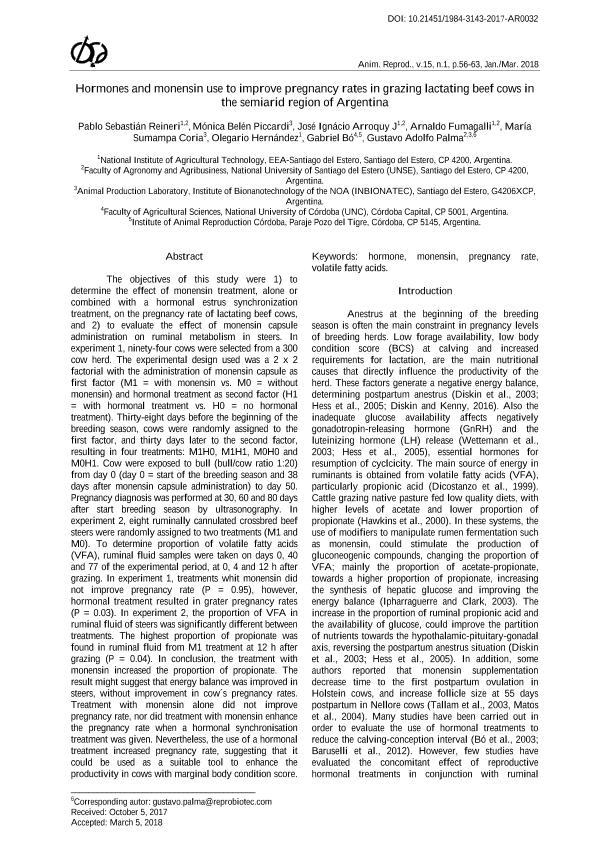Mostrar el registro sencillo del ítem
dc.contributor.author
Reineri, Pablo Sebastian

dc.contributor.author
Piccardi, Mónica Belén

dc.contributor.author
Arroquy, Jose Ignacio

dc.contributor.author
Fumagalli, Arnaldo Enrique

dc.contributor.author
Coria, Maria Sumampa

dc.contributor.author
Hernandez, Olegario

dc.contributor.author
Bo, Gabriel Amilcar

dc.contributor.author
Palma, Gustavo Adolfo

dc.date.available
2019-12-18T12:41:39Z
dc.date.issued
2018-06
dc.identifier.citation
Reineri, Pablo Sebastian; Piccardi, Mónica Belén; Arroquy, Jose Ignacio; Fumagalli, Arnaldo Enrique; Coria, Maria Sumampa; et al.; Hormones and monensin use to improve pregnancy rates in grazing lactating beef cows in the semiarid region of Argentina; Colégio Brasileiro de Reprodução Animal; Animal Reproduction; 15; 1; 6-2018; 56-63
dc.identifier.issn
1806-9614
dc.identifier.uri
http://hdl.handle.net/11336/92463
dc.description.abstract
The objectives of this study were 1) to determine the effect of monensin treatment, alone or combined with a hormonal estrus synchronization treatment, on the pregnancy rate of lactating beef cows, and 2) to evaluate the effect of monensin capsule administration on ruminal metabolism in steers. In experiment 1, ninety-four cows were selected from a 300 cow herd. The experimental design used was a 2 × 2 factorial with the administration of monensin capsule as first factor (M1 = with monensin vs. M0 = without monensin) and hormonal treatment as second factor (H1 = with hormonal treatment vs. H0 = no hormonal treatment). Thirty-eight days before the beginning of the breeding season, cows were randomly assigned to the first factor, and thirty days later to the second factor, resulting in four treatments: M1H0, M1H1, M0H0 and M0H1. Cow were exposed to bull (bull/cow ratio 1:20) from day 0 (day 0 = start of the breeding season and 38 days after monensin capsule administration) to day 50. Pregnancy diagnosis was performed at 30, 60 and 80 days after start breeding season by ultrasonography. In experiment 2, eight ruminally cannulated crossbred beef steers were randomly assigned to two treatments (M1 and M0). To determine proportion of volatile fatty acids (VFA), ruminal fluid samples were taken on days 0, 40 and 77 of the experimental period, at 0, 4 and 12 h after grazing. In experiment 1, treatments whit monensin did not improve pregnancy rate (P = 0.95), however, hormonal treatment resulted in grater pregnancy rates (P = 0.03). In experiment 2, the proportion of VFA in ruminal fluid of steers was significantly different between treatments. The highest proportion of propionate was found in ruminal fluid from M1 treatment at 12 h after grazing (P = 0.04). In conclusion, the treatment with monensin increased the proportion of propionate. The result might suggest that energy balance was improved in steers, without improvement in cow's pregnancy rates. Treatment with monensin alone did not improve pregnancy rate, nor did treatment with monensin enhance the pregnancy rate when a hormonal synchronisation treatment was given. Nevertheless, the use of a hormonal treatment increased pregnancy rate, suggesting that it could be used as a suitable tool to enhance the productivity in cows with marginal body condition score.
dc.format
application/pdf
dc.language.iso
eng
dc.publisher
Colégio Brasileiro de Reprodução Animal
dc.rights
info:eu-repo/semantics/openAccess
dc.rights.uri
https://creativecommons.org/licenses/by/2.5/ar/
dc.subject
HORMONE
dc.subject
MONENSIN
dc.subject
PREGNANCY RATE
dc.subject
VOLATILE FATTY ACIDS
dc.subject.classification
Ganadería

dc.subject.classification
Producción Animal y Lechería

dc.subject.classification
CIENCIAS AGRÍCOLAS

dc.title
Hormones and monensin use to improve pregnancy rates in grazing lactating beef cows in the semiarid region of Argentina
dc.type
info:eu-repo/semantics/article
dc.type
info:ar-repo/semantics/artículo
dc.type
info:eu-repo/semantics/publishedVersion
dc.date.updated
2019-10-22T15:50:37Z
dc.identifier.eissn
1984-3143
dc.journal.volume
15
dc.journal.number
1
dc.journal.pagination
56-63
dc.journal.pais
Brasil

dc.journal.ciudad
Belo Horizonte
dc.description.fil
Fil: Reineri, Pablo Sebastian. Instituto Nacional de Tecnología Agropecuaria; Argentina
dc.description.fil
Fil: Piccardi, Mónica Belén. Consejo Nacional de Investigaciones Científicas y Técnicas. Centro Científico Tecnológico Conicet - Córdoba; Argentina
dc.description.fil
Fil: Arroquy, Jose Ignacio. Consejo Nacional de Investigaciones Científicas y Técnicas. Centro de Investigaciones y Transferencia de Santiago del Estero. Universidad Nacional de Santiago del Estero. Centro de Investigaciones y Transferencia de Santiago del Estero; Argentina
dc.description.fil
Fil: Fumagalli, Arnaldo. Instituto Nacional de Tecnología Agropecuaria; Argentina. Universidad Nacional de Santiago del Estero; Argentina
dc.description.fil
Fil: Coria, Maria Sumampa. Universidad Nacional de Santiago del Estero. Instituto de Bionanotecnología del Noa. Consejo Nacional de Investigaciones Científicas y Técnicas. Centro Científico Tecnológico Conicet - Tucumán. Instituto de Bionanotecnología del Noa; Argentina
dc.description.fil
Fil: Hernández, Olegario. Instituto Nacional de Tecnología Agropecuaria; Argentina
dc.description.fil
Fil: Bo,Gabriel. Universidad Nacional de Córdoba; Argentina. Instituto de Reproduccion Animal Córdoba; Argentina
dc.description.fil
Fil: Palma, Gustavo Adolfo. Universidad Nacional de Santiago del Estero. Facultad de Agronomía y Agroindustrias; Argentina
dc.journal.title
Animal Reproduction
dc.relation.alternativeid
info:eu-repo/semantics/altIdentifier/doi/https://dx.doi.org/10.21451/1984-3143-2017-AR0032
dc.relation.alternativeid
info:eu-repo/semantics/altIdentifier/url/https://www.animal-reproduction.org/article/doi/10.21451/1984-3143-2017-AR0032
Archivos asociados
